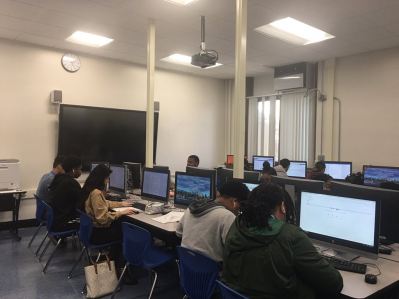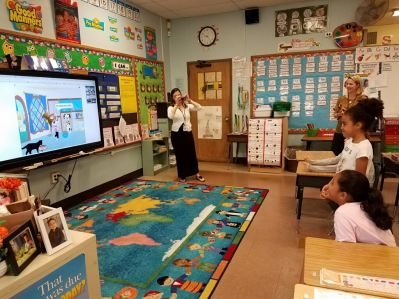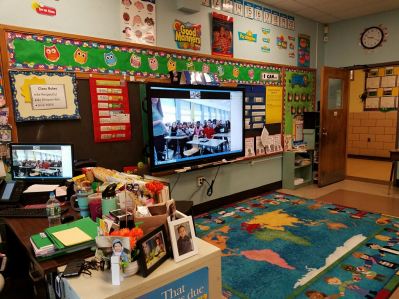Nassau BOCES - Instructional Technologies Transforming Education: How the Model Schools Program has Partnered with School Districts to Assist in a Pedagogical Shift
Professional development and teacher training is more than something we do to fill time; it is an essential component of effective instruction. The most difficult aspect of conducting professional development and teacher training is scheduling. Because of all the personal and professional pressures that educators face, most districts view the school day as the ideal time to advance teacher learning. With that said, the question of “how” often arises. In some cases, the most effective manner of training is to pull the educator from their classroom for the professional development and/or training. With instructional time being of paramount importance, school building and district leadership are often hesitant to remove teachers from their classrooms for these opportunities. For this reason, there is a growing trend within the Nassau County school community to make professional development more of a holistic experience, meaning that trainers and teachers work together to develop programs where the training is directly in line with the classroom instruction.
Trainers and teachers work together, delivering content to students to meet instructional goals while implementing innovative strategies never before possible. Many times, the SAMR (Substitution, Augmentation, Modification, Redefinition) model developed by Dr. Ruben Puentedura is used as a guide for these learning opportunities. In using the SAMR model, reasonable expectations are set in the use of instructional technology within a given lesson or unit of study. In some cases, the simple “substitution” of one instruction tool is made for an instructional technology without any functional change to the activity. While in other instances, a complete “redefinition” of the unit of study or lesson occurs which ultimately develops a learning experience for students that previously would have been impossible to accomplish. As the professional development opportunity progresses, modifications are made to the overall use of the instructional technologies while always being cognizant of the needs of the students and the educational standards which need to be met (Puentedura, 2018).
Above, left: Students in the Nassau County School District working in a computer lab. Below, right: Students playing a virtual learning game in the classroom.
A prime example that highlights the professional development process and the productive partnership between Nassau BOCES and school districts is the ongoing work in Valley Stream Central High School District. Valley Stream is a village in the town of Hempstead, along the border with Queens, New York City. Valley Stream Central High School District serves 991 students (New York State Education at a Glance, 2018) of which 71% are African American/Hispanic and 42% are economically disadvantaged. Valley Stream technology administrators understand the importance of preparing their students with 21st century skills, and in turn, proactively planned for the necessary support that teachers would need to incorporate these skills in their classrooms. As part of their technology plan, their goal was to “establish a continuum of professional staff development on the use of existing and evolving instructional modes needed with an emphasis on the use of instructional technology” (Valley Stream Central HS District Instructional Technology Plan, 2016). They requested 27 Model Schools professional development days in the 2017-2018 school year; after they realized the positive effect the partnership had on their staff, they increased their request to 65 days for the 2018-2019 school year.
Successful and productive partnerships must be grounded in trust and not be evaluative. Teachers must feel the freedom to explore and take risks with built in support. Chrissy Breglia, a Model Schools instructional technology specialist at Nassau BOCES, and a former High School Social Studies teacher currently works with the teachers in the Valley Stream Central High School District to support their integration of instructional technology. Breglia has been sharing new applications and tools that are relevant to the teachers’ subject and grade levels. Based on the needs of the teachers, Breglia tailored the delivery of professional development to the district, providing 1:1 teacher planning, and in-classroom support.
Breglia has been collaborating with Alisha Varian, a high school social studies teacher for over a year. The two quickly built the foundational components necessary for a successful partnership. "The fact that all Model Schools people are teachers make such a difference - they understand the demands. With the introduction of any new technology, you need the support of your school. I was lucky to be given the time to spend with someone so well trained in technology. The students respect her as a teacher and often ask her for help," Varian expressed. She was excited to try new technology tools to prepare her students for college, build student engagement and collaboration, and to personalize their learning experience, but noted that it was very intimidating. "I wanted to change things, but this was outside of my comfort zone. Building the relationship and trust has been a learning process." As a former Social Studies teacher herself, Breglia was excited to collaborate and brainstorm new ideas with Varian to transform the learning in her 12th grade government class.
Every year in Varian’s class, students complete a collaborative research paper where they are asked to research a social problem and create a persuasive essay highlighting opposing sides and viewpoints. In previous years, Varian struggled to keep track of student work and progress, and students had to meet in person to work collaboratively, which proved to be difficult at times. Varian and Breglia agreed that this project could be elevated and transformed with the integration of technology. Valley Stream Central High School District chose the Microsoft Office 365 suite of software to utilize as a school district. Teachers have the option to utilize Microsoft TEAMS, a classroom management system within the software suite similar to Google Classroom. Varian shared, "[Breglia and I] thought introducing TEAMS would help with addressing the needs of all the learners in my inclusion class; visual components, audio components, and organization. The organizational component helps with co-teachers as well and we have the class more organized and prepared for success."
Collaboration and commitment to teacher support with technology implementation and integration has been at the heart of the relationship between Model Schools and the Freeport School District. “Effective PD provides teachers with adequate time to learn, practice, implement, and reflect upon new strategies that facilitate changes in their practice,” and when ongoing support is offered for teachers, they will be more likely to explore, try new things and succeed with the integration of new skills to the benefit of their students (Darling-Hammond, 2017). The district’s technology vision states, “high quality instructional technologies will be used in all classrooms in the Freeport School District. These instructional technologies will support students and teachers in daily, effective use of technology in standards-based lessons to achieve high standards for students” (Three-Year Technology Plan, 2013). As part of their technology integration vision, Freeport Schools understood that their teachers and students would need to be properly supported; this is evident in their purchasing of 100 Model Schools days for integrated professional development in instructional technology for 2017-2018 school year.
Above, left: Students connecting with another classroom via video-conference.
The Freeport Schools technology team, Nicole Pecora and Casey Levine, worked closely with Jessica Gregorovius, a Model Schools instructional technology specialist at Nassau BOCES to develop and support technology integration in the district. The district used different professional development models throughout their partnership, which began in 2015, to implement instructional technology support, and it has evolved and varied throughout the years. At times, Gregorovius facilitated large and small group professional development trainings and other times she worked 1:1 with teachers, pushing into classrooms to provide support as they explore new technology. She notes that the most effective and rewarding time she spends in Freeport Schools is working 1:1 with teachers and small groups of grade level teams. She also stated that the collaborative relationship that she has built with Nicole Pecora paved the way for successful projects and implementations district wide. There are many success stories in this years-long partnership and one culminating project was recently being shared at the 2018 Long Island Technology & Education Summit (a BOCES hosted platform dedicated to the sharing of educational technology projects and initiatives).
Freeport, a suburban community in the town of Hempstead on Long Island’s south shore, serves 6,820 students, of which 71% are considered “economically disadvantaged” (Nassau County Data, 2018). The student population is largely Hispanic and serves a large ELL population (20%). Pecora, Levine and Gregorovius had a deep understanding of the needs of the community and wanted to embark on a collaborative project that would support literacy (their ELA scores are 20% below the average for the rest of Nassau County), their large English language learner population, as well as facilitate learning and collaboration across grade levels. They understood that utilizing visuals and expression through technology supports language development, and wanted to embark on a project that would have a meaningful impact on their students (Brozek & Duckworth, 2011).
The team had a brainstorm session where they discussed how to facilitate the project across grade levels. At the high school level, students had been using Google CS First Storytelling, a computer science program, to tell fun and interactive stories. CS First is a free web-based program that exposes students to computer science through video tutorials and modules that students participate in as after-school, in-school and summer programs. CS First projects involve block-based coding using the MIT Scratch platform (Google CS First ignites interest in computer science, 2018). Scratch is a block coding program that people all over the world are using to learn to code. Scratch allows students to program their own interactive stories, games, and animations, and share their creations with others in the online community. It helps young people learn to think creatively, reason systematically and work collaboratively, all of which are essential skills for life in the 21st century. In the second grade writing curriculum, students had been working on narrative writing and were learning the elements of good storytelling. Second grade teachers were eager to find resources to support their students in developing their writing skills - they knew that technology could be a supportive vehicle. The Freeport Schools/BOCES technology team saw this as an opportunity to use technology to “reinvent” teaching and learning in both the high school and second grade classrooms.
Second grade students worked hard at crafting narrative stories, with the added bonus that their story would be brought to life in an animated video. They met virtually with the high school students who would be creating the animations and shared ideas and suggestions. They become “virtual pen pals," writing to each other throughout the process, asking clarifying questions and checking in on progress. The team did face their share of challenges, mostly regarding scheduling, time constraints and coordinating communication between teachers in different buildings. However, the team worked out their scheduling kinks and found success through their determination. The culmination of the project was a successful reinvention of narrative writing, that would not have been possible without the collaboration and dedication of many and the integration of new technology. Second graders felt the value of their work and their writing reached a wider, authentic audience. High school students practiced computer science and coding skills while understanding and learning how to bring someone else’s vision to life - redefining the teaching and learning of both classes and therefore reaching the highest level of the SAMR technology integration model: redefinition (Puentedura, 2018).
Success stories such as the collaborative projects in Valley Stream Central High School District and the CS First project in Freeport Schools are only possible with buy-in from district leaders, dedicated teachers and the follow through, collaboration and commitment of the BOCES Model Schools program specialists. Nassau BOCES will continue to promote best practices for teachers and advance the educational experiences for the over 200,000 students in Nassau County schools.
Works Cited
- Brozek, E., & Duckworth, D. (2011, March). Supporting English Language Learners Through Technology. Retrieved from NYSUT.org.
- Darling-Hammond, L. H. (2017). Effective Teacher Professional Development. Learning Policy Institute.
- Digital Age Teaching and Education Program (Model Schools). (2018, October 24). Retrieved from Nassau BOCES.
- Google CS First Ignites Interest in Computer Science. (2018, December 12). Retrieved from ISTE.
- Nassau BOCES. About Us. (2018, October 24). Retrieved from Nassau BOCES.
- Nassau BOCES. Council for Curriculum and Instruction. (2018, October 26). Retrieved from Nassau BOCES.
- Nassau County Data. (2018, October 24). Retrieved from data.nysed.gov.
- Nassau Regional Information Center (RIC). (2017-18 data). L2RPT SIRS 350 report and Level 1 data warehouse. Nassau BOCES.
- New York State Education at a Glance. (2018, December 11). Retrieved from data.nysed.gov.
- Puentedura, D. R. (2018, September 28). SAMR and the Learning Design Process. Retrieved from Ruben R. Puentedura's Blog.
- Three-Year Technology Plan. (2013). Retrieved from Freeport Public Schools.
- Valley Stream Central HS District Instructional Technology Plan. (2016, June). Retrieved from Valley Stream Central HS District.








